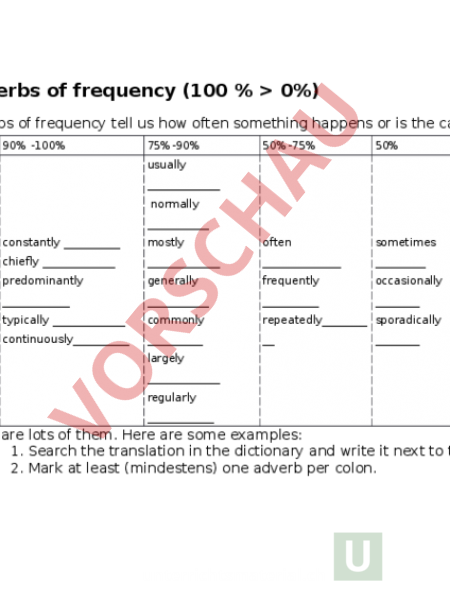Arbeitsblatt: adverbs of frequency
Material-Details
theorie erarbeiten
Englisch
Grammatik
7. Schuljahr
2 Seiten
Statistik
162610
364
5
12.07.2016
Autor/in
Sarah Elena Deppeler
Land: Schweiz
Registriert vor 2006
Textauszüge aus dem Inhalt:
Adverbs of frequency (100 0%) Adverbs of frequency tell us how often something happens or is the case. 100% 90% -100% 75%-90% 50%-75% 50% 25% 0% usually normally constantly mostly often sometimes chiefly always predominantly generally frequently occasionally typically commonly repeatedly sporadically continuously rarely seldom infrequently largely regularly There are lots of them. Here are some examples: 1. Search the translation in the dictionary and write it next to the adverb 2. Mark at least (mindestens) one adverb per colon. never Rules: Erkläre folgende Regeln in deinen eigenen Worten auf Deutsch. 1 The adverb comes after people and things: If the sentence has one verb in it we put the adverb after the subject (person, pronoun, things), so before the full verb: subject adverb verb end of sentence Tom Toms car usually usually goes works to work by car. well. 2 The adverb comes after the verb be: If the sentence has form of the verb «to be» in it we put the adverb after the auxiliary verb: subject auxiliary verb adverb end of sentence Tom Anne is isnt often usually late. late. 3 The adverb comes after the auxiliary verb If the sentence has more than one verb in it we put the adverb after the auxiliary verb: subject auxiliary verb adverb full verb can never remember end of sentence his name. 4 In questions The adverb comes after the subject. When we ask question, we put the adverb of frequency before the main verb, that is after the subject. auxiliary verb subject adverb main verb en end of sentence Do Does you she often usually go do to the cinema? her homework? 5 In negative statements The adverb comes after the subject. When make sentence negative, we put the adverb before the main verb, that is after the auxiliary verb. subject auxiliary verb adverb main verb end of sentence They dont often go to the cinema.
